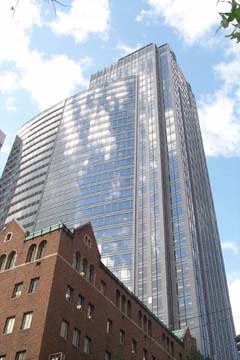|
Subscribe / Renew |
|
|
Contact Us |
|
| ► Subscribe to our Free Weekly Newsletter | |
| home | Welcome, sign in or click here to subscribe. | login |
Real Estate
| |
 |
October 3, 2002
A fresh approach for Seattle’s newest high-rise
Zimmer Gunsul Frasca Partnership

Photo by Jon Silver The south façade of the IDX Tower cantilevers over the YMCA (lower left) to maximize the area of each floor. The building’s exterior walls are clad in granite, metal and glass, rising uninterrupted to a detailed, flood-lit silver crown. |
The IDX Tower is built on one of the last and most prominent development parcels in Seattle’s financial district and is the largest commercial office building to be built in downtown Seattle in more than a decade.
The 40-story, 846,588-square-foot mixed-use development, located between Third and Fourth avenues and Madison and Marion streets, shares its block with the historic downtown YMCA, located on this site since 1907.
A civic approach
To be competitive in this real estate market, the sleek, modern, granite-clad high-rise required a fresh, almost civic approach to designing a tall commercial office building.
Spurred by a reaction to the construction boom of the early 1980s, the CAP (Citizens’ Alternative Plan) Initiative passed by the citizens of Seattle in 1989, limited the height and bulk of downtown buildings, affecting the site for the new IDX Tower.
These zoning regulations, coupled with present market demands for much larger floor plates than were required in the past, dictated a tower design much shorter and broader than its immediately adjacent neighbors. A short “dumpy” building could be the result.
Therefore, a creative design solution was required, not only to make the tower viable and desirable to potential office tenants, but also to create successful urban architecture and an architectural expression to distinguish the building from its taller neighbors in the Seattle skyline.
Additional design objectives included maximizing the size and efficiency of the individual floor plates, taking full advantage of views in all directions, respecting the adjacent historic YMCA and activating each of the four surrounding streets.
Cathedrals of commerce
The mass of the tower is placed to the north side of the site with its long axis in the east-west direction to preserve views past the adjacent office buildings to the waterfront and to respect its historic neighbor.
In addition, the south façade of the tower gracefully cantilevers over the YMCA to maximize the area of each floor. This portion of the building is expressed as a gently curving glass curtain wall to appear visually light and to create a uniform backdrop to showcase the YMCA building.
To further extend the building’s urban influence, large interior rooms are created on each street as through-block connections with their design inspired by magnificent ground floor halls of past landmark office towers known as “cathedrals of commerce.”
The lobby on Third Avenue is a grand civic room that incorporates a major art installation and one of the few public spaces of its kind in the city accessible directly from the sidewalk.
To reduce the impact of the 60-foot grade change and to encourage pedestrian traffic, escalators connect the lobby at the Third Avenue level through the spacious retail concourse to the Fourth Avenue lobby. This lobby is the front door and the ceremonial entrance for tenants of the building.
|
The building entrances on the steep streets of Marion and Madison are designed with their own entrance lobbies and steps gracious enough to accommodate both sitting and lingering. The quality interior finish materials further enhance the civic aspects of the building’s public spaces.
Energizing the street
The mass of the building’s podium is carefully scaled to not overwhelm the YMCA or the Federalist-era Central Building to the south.
Each façade of the building’s base is designed to be visually stimulating and architecturally rich with a detail scale more refined and more civic than some of the adjacent “cultural” buildings. The pedestrian environment along Third Avenue is enhanced by street furniture and storefronts designed to accommodate small and medium-sized retail businesses consistent with the scale of the shops that existed previously on the site.
On the corner of Madison Street and Fourth Avenue, outside the building lobby, a landscaped terrace is designed to energize the street and provide space for outside dining for one of the building’s restaurants. An additional large landscape terrace occupies the roof of the podium. An amenity for the building’s occupants, the garden terrace will provide a wonderful sun-filled outdoor gathering space with views of the stadiums and the waterfront.
A silver crown
Though elegant, and crafted at a scale and quality usually reserved for civic buildings, the visual success of the IDX Tower depends largely on the overall composition rather than on individual details.
The tower is expressed as two intersecting masses; the taller detailed in vertical columns of light-gray stone to accentuate its height, and the other clad in a glass curtain wall with horizontal bands of silver metallic spandrel glass.
The building’s maximum height is revealed when viewed from the north along Fourth Avenue as it rises uninterrupted from the street to its detailed, flood-lit silver crown. The light color palette of granite, metal and glass, the finely detailed exterior walls and building crown distinguish the IDX Tower from its much taller neighbors.
The tower is complex rather than simple, rich rather than reductive, with multiple images rather than singular. Constructed from private funds by a premier international developer, the IDX Tower is successful in offering premier office space to today’s demanding tenants. In addition, the building’s design strives to respond to its special context and effectively craft urban architecture of civic quality.
Ev Ruffcorn, FAIA, is the partner-in-charge of design and the designer of the IDX Tower for the Seattle office of Zimmer Gunsul Frasca Partnership, a 385-person design firm specializing in architecture, planning and interior design.
Other Stories:


